ASRock B550 Taichi Review: The $300 B550 Motherboard with Chutzpah
by Gavin Bonshor on August 21, 2020 3:30 PM EST- Posted in
- Motherboards
- AMD
- ASRock
- Taichi
- AM4
- Ryzen 3000
- Ryzen 3700X
- Ryzen 4000
- B550
- B550 Taichi
Visual Inspection
The ASRock B550 Taichi is as ornate as any model from its Taichi series, with an elegant bronze and black color theme throughout. The rear panel cover includes separate RGB areas for the Taichi logo and where the model and is primarily gold in color, as well as the power delivery heatsink. While not a conventional color, the lower portion of the board has black and bronze PCIe armor with a lightly embossed Taichi cogwheel inspired patterning. This cogwheel patterning stretches to the chipset heatsink, with a very classy finish and also includes some RGB LEDs. On the underside of the right-hand section of the board is a long RGB LED strip that provides a nice under glow.
Looking to the boards PCIe, and the top two full-length slots operates at PCIe 4.0 driven directly from a Ryzen 3000 series processor. When the top slot is the sole one active, it runs in x16 mode, however if both are populated, it splits into x8/x8. The other full-length slot operates at PCIe 3.0 x4, and sandwiched in between the full-length slots are two PCIe 3.0 x1 slots. There are a pair of M.2 heatsinks which fit nicely into the board's bronze and black aesthetic - the first one is a top-mounted PCIe 4.0 x4 M.2 slot, while the bottom M.2 slot operates at PCIe 3.0 x4.
Along the bottom of the B550 Taichi is a basic overclockers toolkit which includes a two-digit LED Debugger, a power button, a reset button, and a small clear CMOS button. Located around the board are seven 4-pin headers which are split into three different cooling segments, one for a CPU fan, one for an optional CPU fan and a water pump, and five for regular chassis fans.
The B550 Taichi also has eight SATA ports, which is the only current B550 model to include this, with four of the eight controlled by the chipset and the other four made available from the use of an ASMedia ASM1061 SATA controller. The four SATA ports controlled by the chipset support RAID 0, 1, and 10 arrays.
Located at the top right-hand corner are four memory slots which include support for up to DDR4-5000 memory, while a total of 128 GB can be installed with official support for 32 GB UDIMM memory. The B550 Taichi does include support for ECC and non-ECC memory, although users opting for ECC memory should note that it will operate un-buffered modules.
The power delivery on the ASRock B550 Taichi is made up of a 16-phase design with fourteen phases for the CPU, and two for the SoC. ASRock has opted to use sixteen Vishay SiC654 50 A DrMos power stages which makes up both the CPU and SoC sections. The PWM controller of choice is an Intersil ISL229004 which is an 8-channel controller which means the power delivery is operating in a 7+1 configuration. The B550 Taichi's doubler of choice is the Intersil ISL6617A with seven doubling up the fourteen CPU power stages and one doubling up the two SoC phases. Providing power to the power delivery is a pair of 12 V ATX CPU power inputs.
Cooling the large 16-phase power delivery is a pair of bronze-colored aluminum heatsinks which are interconnected by a single heat pipe. On both of the heatsinks is a relatively thick thermal pad with fairly deep impressions which shows a good mounting between the power delivery and the heatsinks.
For audio, the ASRock B550 Taichi is using a Realtek ALC1220 HD audio codec with five Japanese Nichicon gold audio capacitors which are specifically designed for audio solutions such as this. To improve the quality of the front panel audio header, ASRock has included a Texas Instruments NE5532 headset amplifier which can drive headphones and headsets up to 600 Ohm. The audio PCB itself includes a faint yellow separation line from the rest of the board to help protect the audio componentry from electronic magnetic interference, although the ALC1220 HD codec does not include a separate dedicated EMI shield.
On the rear panel I/O is a variety of input and output with a single USB 3.2 G2 Type-C, one USB 3.2 G2 Type-A, four USB 3.2 G1 Type-A, and two USB 2.0 port, with all of the rear panel USB coming with ESD protection. The board's networking consists of a single Intel I225-V 2.5 GbE Ethernet controller which powers the single RJ45 port, while the two antenna ports are for the Intel AX201 Wi-Fi 6 interface which includes support for BT 5.1 devices. Onboard audio is provided by the way of five 3.5 mm audio jacks and a single S/PDIF optical output powered by a Realtek ALC1220HD audio codec. Finishing off the rear panel is a clear CMOS button, and a BIOS flashback button which can be used to update the board's firmware without a CPU/memory/display installed.
Also present on the rear panel is a pair of video outputs that consist of an HDMI and DisplayPort 1.4 output. This allows users to use integrated graphics when AMD puts the next-generation APUs on retail shelves.
What's in the Box
Included within the ASRock B550 Taichi accessories bundle are four SATA cables, an Intel AX201 Wi-Fi 6 antenna kit, an ASRock branded Torx screwdriver, and two M.2 installation screw kits. Other accessories include a quick installation guide and a driver/software installation disc.
- Quick installation guide
- Driver and software installation disc
- ASRock Torx screwdriver
- 4 x SATA cables
- 2 x M.2 screws
- 2 x M.2 standoffs
- ASRock Taichi postcard
- 2 x ASRock velcro cable ties
- ASRock Taichi sticker set


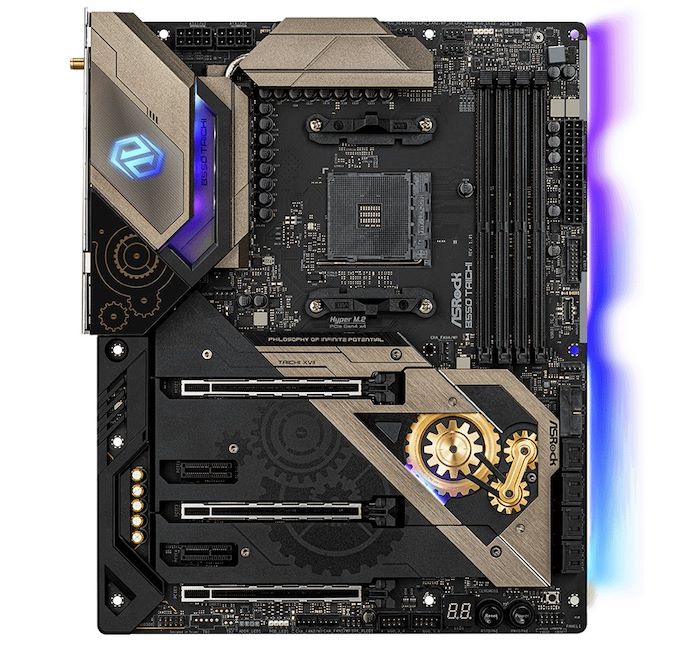
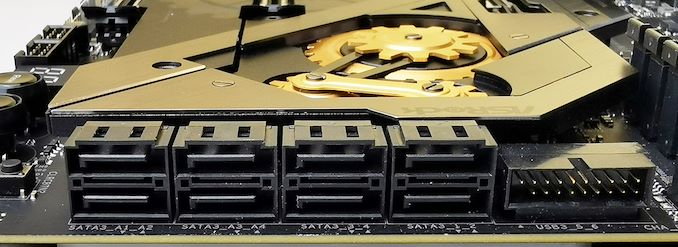
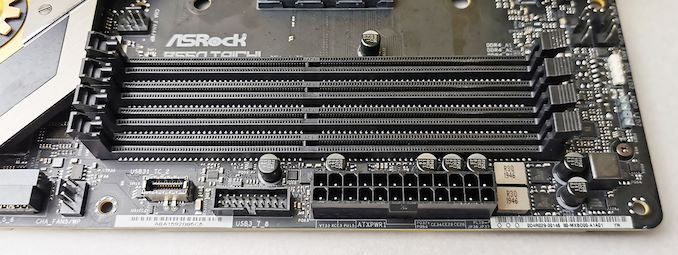
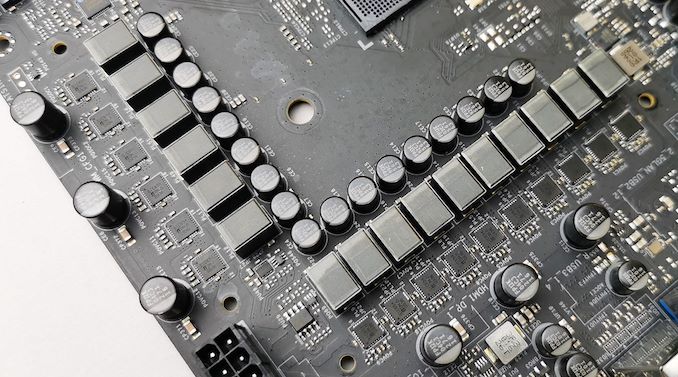
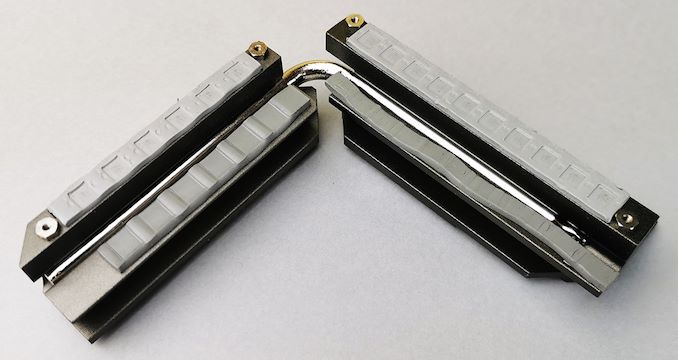
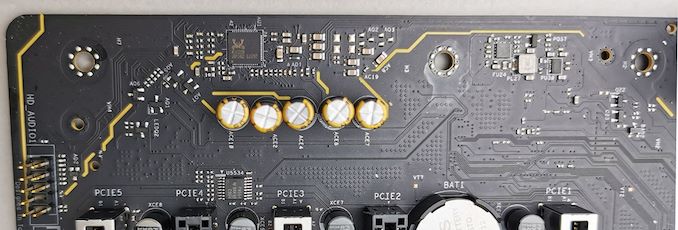

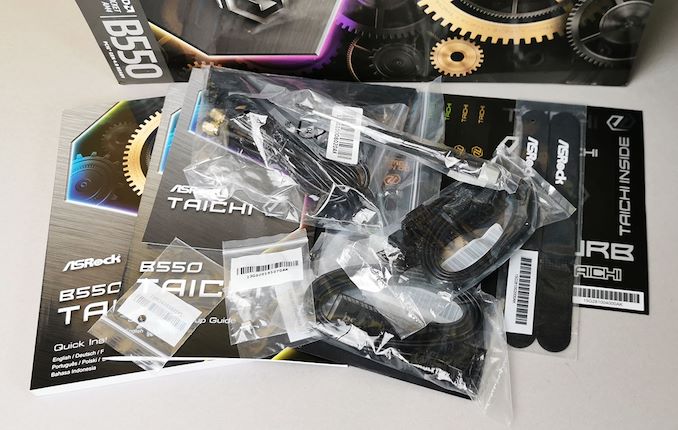








61 Comments
View All Comments
Gigaplex - Saturday, August 22, 2020 - link
I just bought a B550 motherboard. It was 30% cheaper and had features that the X570 version didn't have (eg 2.5Gbit ethernet, better accoustics due to lack of a chipset fan).WaltC - Saturday, August 22, 2020 - link
$360 x570 Aorus Master is a far better buy. BTW, I've never heard the chipset fan even once. Got a lot more features than this B550 mboard. Had my x570 AM over a year and its doing great--and I still haven't seen anything better on the market--other than the Xtreme--which for me would be overkill and cost 2x as much.kkilobyte - Sunday, August 23, 2020 - link
Except when the Aorus Master suddenly refuses to boot, requiring you to remove the CMOS battery to revive it. Which is something that happens a bit too often - and Gigabyte still unable to solve the issue.Showtime - Monday, August 24, 2020 - link
When going AMD, they get you on the motherboards. You also need more expensive ram to maximize performance. I was interested in AMD this round, but the Intel non k chips give the same,or better gaming performance, and actually come out to the same or less depending on motherboard, and ram. $200+ b series mobo's are just bad investments IMO.yannigr2 - Friday, August 21, 2020 - link
Would you please check something about B550 X570 boards?Here the Taichi has the option to drive both top PCIe x16 slots from the CPU. IF I am not mistaken.
On the other hand the majority of B550 AND X570 boards seems to connect only the first PCIe x16 slot on the CPU and EVERYTHING ELSE on the chipset. Even if they have 2 or 3 PCIe x16 slots. That means that in many cases ports get disabled when other ports are populated.
hetzbh - Friday, August 21, 2020 - link
No AM4 based can drive 2 PCIe X16 from the CPU (I wish..) since the Ryzen 2xxx/3xxx has 24 PCIe lanes out from the CPU. 4 goes to the chipset, 4 goes to NVME M.2, and the last 16 goes to the first PCIe slot and can be shared (X8/X8) between 2 slots, but no X16/X16.yannigr2 - Friday, August 21, 2020 - link
I wasn't talking about driving two PCIe x16 ports. I was talking about splitting those 16 lanes to a typical x8 / x8 configuration.While this was the obvious case in most AM3 motherboards for example, in many cases, even with x570 boards with two or three PCIe X16 slots, only the first slot is connected to the CPU. The second (and third is their is one) PCIe x16 together with the couple x1 ports are connected in the Chipset. So you read. If you connected something in the second M2, you lose that PCIe slot. If you connect something in that PCIe slot, you lose the other PCIe slot and etc.
yannigr2 - Friday, August 21, 2020 - link
One example of a 570 that does thisASUS PRIME-X570-P
https://www.asus.com/Motherboards/PRIME-X570-P/spe...
1 x PCIe 4.0 x16 (x16 mode)
AMD X570 chipset
1 x PCIe 4.0 x16 (max at x4 mode)
3 x PCIe 4.0 x1
So, form the two PCIe x16, only the first is connected to the CPU. The second is connected on the chipset.
You have a microATX motherboard disguised as a full ATX.
Hyoyeon - Friday, August 21, 2020 - link
In order to bifurcate the x16, boards need some logic to mux/demux the lanes. Switching up to nearly 32 GB/s of traffic is quite hard, and so the IC's are surprisingly expensive (especially when you get into the really fast things like PCIe 5/6).eddman - Saturday, August 22, 2020 - link
That information can be gathered from the product's page on their website. The following is from this board's page:"single at Gen4x16 (PCIE1)
dual at Gen4x8 (PCIE1) / Gen4x8 (PCIE3)
triple at Gen4x8 (PCIE1) / Gen4x8 (PCIE3) / Gen3x4 (PCIE5)"
They don't specifically mention exactly which slot is connected to what, but from the above info it's apparent that the first two x16 slots are connected to the processor, because the lanes are split when two cards are inserted. The third slot is obviously connected to the chipset.
The Asus example you posted below clearly states the second slot is connected to the chipset.